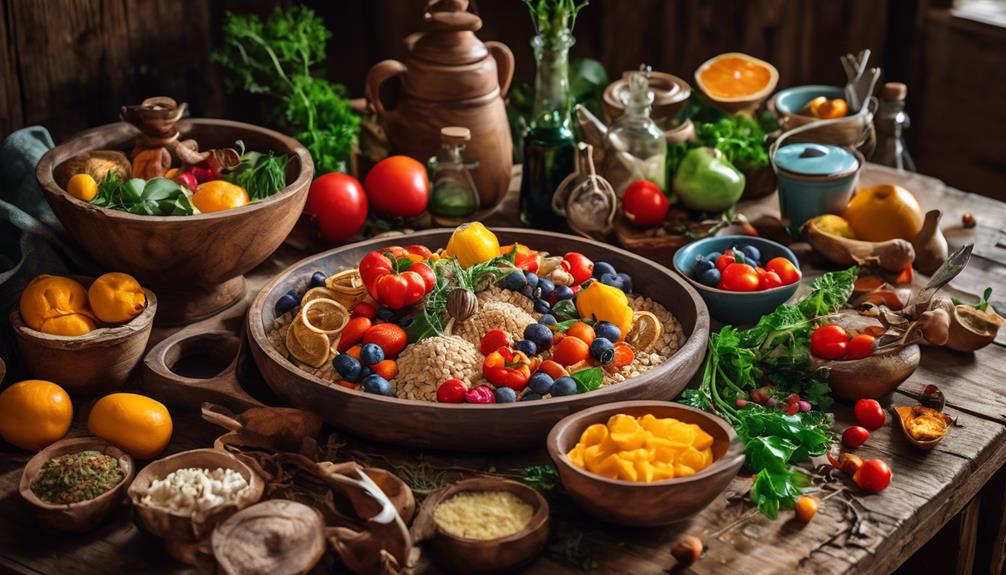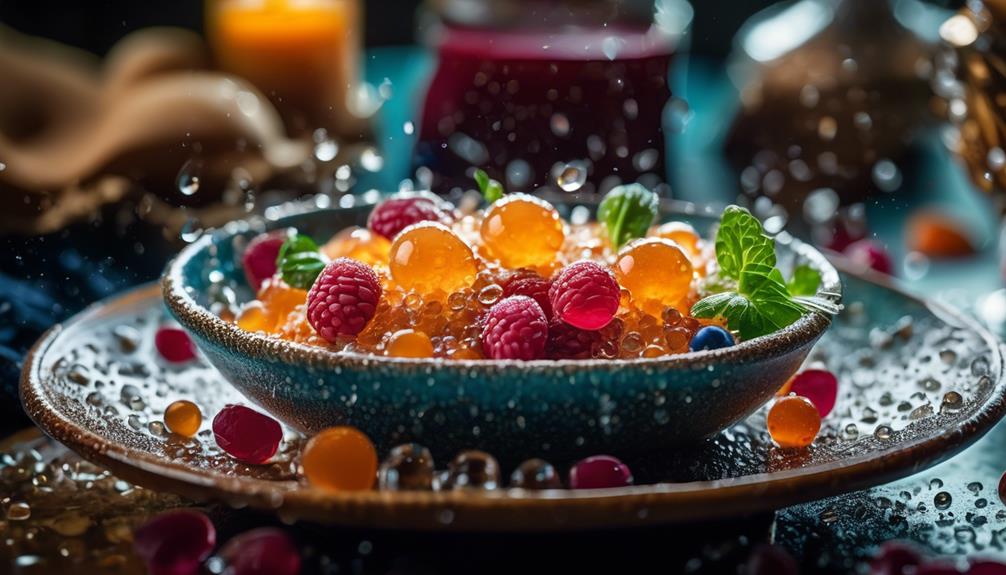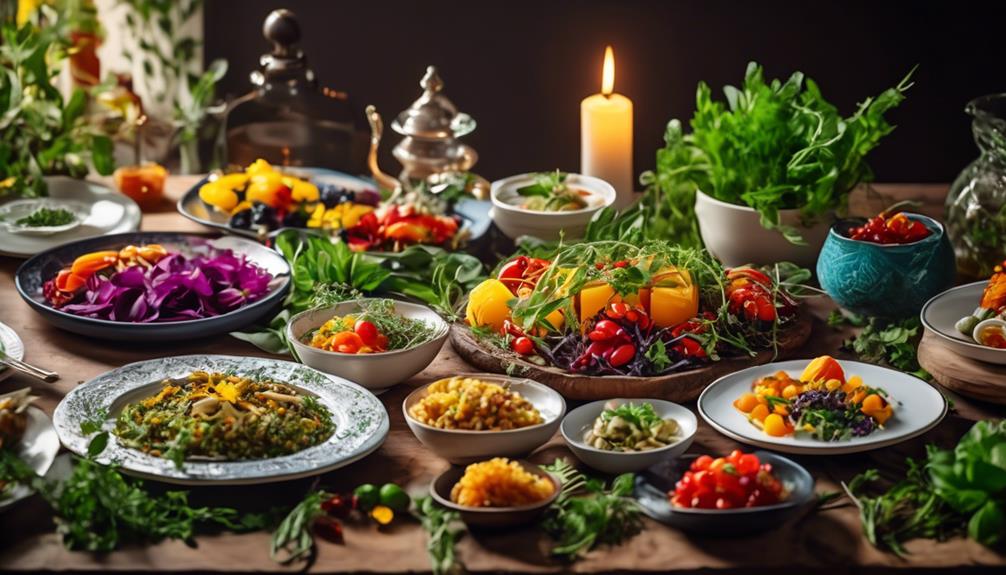Please note this post may contain affiliate links picked by me (Jay) that I have deemed may be of interest or relevant to you the reader of this.
These links do not affect the cost of the thing if you decide to purchase but i may get a little money if you choose to purchase.
For more information on my affiliate link policy click here.
Food and product photography is a delightful journey that allows me to explore the art of capturing delectable dishes and captivating products in a visually appealing way.
It's like embarking on a treasure hunt, seeking inspiration and ideas that will elevate my photography skills to new heights. From creative food styling techniques to mastering lighting and composition, there are endless possibilities to discover.
So, join me as we unravel the secrets behind stunning images and unlock the door to a world filled with inspiration and endless creativity.
Key Takeaways
- Incorporate colorful plating and unique backgrounds to create visually stunning compositions.
- Experiment with different arrangements, styling methods, and props to elevate the dish's visual appeal.
- Pay attention to lighting, composition, and post-processing techniques to capture the perfect product shot.
- Explore different camera angles, perspectives, and artistic interpretations to create remarkable images that set your work apart.
Creative Food Styling Techniques
When it comes to food styling, I find that incorporating unique and imaginative techniques adds an extra layer of creativity and visual appeal to the final photograph. One technique that I love to explore is colorful plating. Instead of simply arranging the food on a plain white plate, I experiment with vibrant and eye-catching colors to create a visually stunning composition. By using a variety of colorful ingredients and arranging them in an artistic manner, I'm able to elevate the dish and make it more visually appealing.
Another technique that I enjoy using is unconventional backgrounds. Instead of relying on traditional surfaces, such as a wooden table or a marble countertop, I like to think outside the box and find unexpected backgrounds that complement the food. This could be anything from a rustic wooden plank to a colorful patterned fabric. By using unconventional backgrounds, I'm able to create a sense of intrigue and surprise in the photograph, capturing the viewer's attention and making them curious about the dish.
Incorporating these techniques not only adds a creative touch to the food styling process but also allows me to create unique and innovative photographs that stand out from the crowd. These techniques are perfect for those who desire innovation and want to push the boundaries of traditional food photography.
Capturing the Perfect Product Shot
Now that we've explored creative food styling techniques, let's dive into the art of capturing the perfect product shot, where every detail and angle plays a crucial role in showcasing the product's beauty and allure.
When it comes to product photography, styling tips and post-processing techniques are essential for creating images that are visually stunning and captivating. Here are four key elements to consider:
- Lighting: Proper lighting is essential in product photography. Experiment with different lighting setups, such as natural light, studio lights, or a combination of both, to highlight the product's features and create a desired mood.
- Composition: Pay attention to the composition of your shot. Consider the rule of thirds, leading lines, and negative space to create a visually pleasing and balanced image. Experiment with different angles and perspectives to find the most flattering and interesting view of the product.
- Props and Background: Select props and backgrounds that complement the product and enhance its overall aesthetic. Use props to add context and tell a story, while choosing backgrounds that are simple and don't distract from the main subject.
- Post-processing: After capturing the perfect shot, post-processing techniques can further enhance the image. Use editing software to adjust exposure, color balance, and sharpness to achieve the desired look. Experiment with different filters and effects to create a unique and eye-catching final image.
Mastering Lighting for Food and Product Photography
To achieve stunning and captivating food and product photography, mastering the art of lighting is essential. Whether you're using natural or artificial lighting techniques, understanding how to manipulate light can greatly enhance your images.
When it comes to natural lighting, the key is to take advantage of the available light sources. Position your subject near a window or in a well-lit area to capture the soft, diffused light that creates a natural and inviting atmosphere. The time of day can also play a significant role in the quality of light. The golden hour, which occurs during sunrise or sunset, provides a warm and flattering glow that can beautifully highlight the textures and colors of your subjects.
On the other hand, artificial lighting techniques allow for more control over the lighting conditions. Using reflectors and diffusers can help enhance the lighting effects and minimize harsh shadows. Reflectors bounce light back onto the subject, while diffusers soften and spread the light, creating a more even and pleasing illumination.
Experimenting with different lighting techniques and equipment can open up a world of possibilities for your food and product photography. By mastering the art of lighting, you can create visually striking images that captivate and inspire your audience.
Composition and Props for Stunning Images
Creating stunning and captivating food and product photography involves careful consideration of composition and the strategic use of props. By employing the right composition techniques and selecting the perfect props, we can enhance the visual appeal of our images and convey a compelling narrative to our audience.
- Color and Texture: Incorporating a variety of colors and textures in your composition adds depth and visual interest to your images. Experiment with different combinations and contrasts to create a dynamic and visually pleasing composition.
- Storytelling and Narrative: Props can play a crucial role in telling a story or conveying a specific message in your photographs. Choose props that align with the theme or concept you want to communicate to your audience, and use them strategically to enhance the narrative of your images.
- Balance and Symmetry: Achieving balance and symmetry in your composition can create a sense of harmony and visual appeal. Experiment with different arrangements and placements of props to find the perfect balance in your images.
- Negative Space: Utilizing negative space can draw attention to your subject and create a sense of simplicity and elegance in your composition. Leave empty spaces around your subject to create a visually pleasing and balanced image.
Exploring Unique Perspectives and Angles
As I explore the fascinating world of food and product photography, I find myself drawn to the endless possibilities of capturing unique perspectives and angles that can truly elevate my images. It's through unconventional setups and artistic interpretations that I discover new ways to showcase the beauty and essence of the subject.
One way to achieve unique perspectives is by experimenting with different camera angles. Instead of shooting from eye level, try getting low to the ground or shooting from above. These perspectives can offer a fresh and unexpected view that adds interest and depth to your photographs.
Another approach is to play with the placement of your subject within the frame. Consider placing it off-center or at the edge of the frame, creating a sense of asymmetry and adding visual tension. This unconventional setup can create a dynamic composition that grabs the viewer's attention.
Furthermore, don't be afraid to experiment with different lenses and focal lengths. Wide-angle lenses can distort the perspective, while telephoto lenses can compress the background, creating a unique visual effect.
Exploring unique perspectives and angles in food and product photography allows for endless creativity and innovation. By thinking outside the box and embracing unconventional setups and artistic interpretations, you can create remarkable images that captivate the audience and set your work apart.
Frequently Asked Questions
What Are Some Tips for Choosing the Best Background and Props for Food and Product Photography?
Choosing the right background and props for food and product photography can greatly enhance the overall aesthetic of the images. Consider the theme and mood you want to convey, and choose backgrounds and props that complement and enhance the subject.
Pay attention to color coordination and ensure the focus remains on the food or product. Experiment with different textures and materials to add depth.
Use natural light whenever possible and play with different perspectives and angles for visual interest.
How Can I Create a Visually Appealing Composition While Keeping the Focus on the Food or Product?
To create visually appealing compositions while keeping the focus on the food or product, I consider the balance between aesthetics and the main subject.
I experiment with different angles, lighting, and props to enhance the overall composition.
By strategically placing the food or product as the focal point and using complementary elements, I can create captivating arrangements.
This approach allows me to showcase the beauty of the subject while maintaining a visually pleasing composition.
Are There Any Specific Lighting Techniques That Can Help Enhance the Textures and Details of the Food or Product?
When it comes to enhancing the textures and details of food or products, exploring different lighting techniques can make all the difference. By playing around with various setups, I've discovered that using soft, diffused light can beautifully highlight the intricate details and textures.
Additionally, experimenting with side lighting or backlighting can add depth and create interesting shadows. The key is to find the right balance that enhances the subject without overpowering it.
What Are Some Creative Ways to Style Food and Products to Make Them Look More Appetizing or Appealing?
When it comes to making food and products look more appetizing or appealing in photography, there are some creative plating techniques that can work wonders. By arranging the food or products in an artistic and visually appealing way, you can make them look more enticing.
Additionally, using props can help create a story and enhance the overall appeal of the photograph. These techniques allow for innovation and can truly elevate your food and product photography to the next level.
Can You Provide Some Examples of Unique Perspectives and Angles That Can Add Visual Interest to Food and Product Photography?
When it comes to food and product photography, unique perspectives and angles can add a whole new level of visual interest. By thinking outside the box and getting creative with your styling, you can really make your images stand out.
From overhead shots to close-ups, there are so many different ways to capture the beauty and appeal of your subject. Experimenting with different angles and perspectives can bring a fresh and innovative touch to your photography.
Conclusion
So there you have it, folks! After delving into the world of food and product photography, you now have all the inspiration and ideas you need to create stunning images.
From mastering creative styling techniques to capturing the perfect shot, lighting, composition, and unique perspectives, you're well-equipped to showcase your culinary creations or products in the most captivating way.
So grab your camera and get ready to make mouths water and hearts skip a beat with your incredible photography skills.
Bon appétit!


